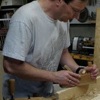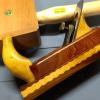1.Name (and nick names):
David Weaver
2. Age/DOB:
34
3. Location (present and previous):
North of Pittsburgh
4. Tell us about your family:
Wife and 2 year-old daughter
5. How do you earn a living, woodworking or other, any interesting previous occupations:
Applied mathematician. I have worked in the same occupation since college. However, during summers in college, I worked in a commercial cabinet factory, which was nothing at all like woodworking as we think of it. The factory made 2700-3500 cabinets per day, depending on orders. Panels were all cut with CNC machinery, everyone had a very specific and narrow job, and I generally worked in the assembly room, which housed five assembly lines and sub-assembly areas (drawer assembly, door hinge installation, etc). Three of the lines were non-specialty (standard size wall and base cabinets, and vanities) and turned each out more than a cabinet a minute. It was fast-paced repetitive work and the wages were low. In those days (the mid/late 90s) the orders just kept coming, but that factory has since been closed due to consolidation and low demand for building materials.
6. Equipment overview (hand tools and other):
Almost entirely hand tools. I have some power tools, but the only ones that get used with any regularity are a small drill press and a bandsaw. I do use a basic spraying setup when I have a reason to build furniture.
7. Describe your shop:
My shop is in front of the cars in a two-car garage, approximately 10x30 of useable space. Probably that much space in an adjacent basement houses most of my hand tools and nicer lumber the garage is below ground can be humid if it rains often. There wouldnít be room for all of it in the shop, anyway.
8. Tell us about the hand planes you own, and your favorite one(s) to use:
Iíve ventured into and through every major type of handplane (woodies, bench planes, infill planes, Japanese planes, European/continental planes), and still have some of each. I donít really have favorites, but I gravitate toward using the planes that Iíve made or mostly made just because of familiarity with them, I guess.
9. Your favorite chisels:
Again, no favorites, really. Iíve run through most of whatís around (new chisels, old chisels, Japanese chisels, Ö), and I guess I tend to like anything made of very plain steel, like old laminated chisels, chisels marketed as cast steel and Japanese white steel chisels.
10. Your favorite handsaw(s):
Generally English-pattern/style saws from the mid 1800s. Thatís not really an official tool class, maybe, but I think the English had a good grasp on how to design and make nice saws, and to the extent that American made handsaws deviate (like fat-plated plain closed-handle backsaws from disston, et al), I tend to like them less.
11. Do you use western tools or Japanese? Why do you prefer the ones you use:
Both. I donít really have a preference. I really like Japanese steel, but as time goes on and more of my tools are tools that Iíve made, or made parts of and assembled. When you start making your own tools, you have a level of familiarity with them that makes them very nice to use, and predictable/reliable, more so than going through large quantities of ďboughtĒ tools that you never develop familiarity with. I do prefer to keep Japanese planes in the mix when dimensioning/roughing lumber because that can be tiring and itís nice to go back and forth between pushing and pulling. Unless I run into financial or space considerations, I donít think Iíll ever go totally one way or the other.
12. Do you have a woodworking home page:
No.
13. Do you have any influences in your work? Certain styles or designers you follow/prefer:
I donít make furniture unless my wife makes requests. At some point, I will admit that I really only have the desire to make tools, as making furniture doesnít draw me to the shop Ė itís more like an obligation. I guess to the extent that Iím making tools, I do like tools that are tastefully designed and donít display elements that immediately strike someone as facilitating manufacture.
14. Do you have any ancestors who were woodworkers that served as inspiration:
No, though my motherís side was, and still is, filled with tinkerers Ė very competent tinkerers, but none were woodworkers. Their tinkering tends to be focused close to their occupations.
15. What is your favorite neander project, or part of a project, you have ever done and why:
Building planes. Any of them. Moulding planes, infill planes, etc. From a sensory (the feel of working metal and wood by hand) and results perspective, the whole process is very satisfying. Plus, you have a tool that you maybe never wouldíve spent the money for, and a choice in where compromises are made.
16. Do you believe there is any spiritual dimension to woodworking with hand tools:
No. Woodworking is a sensory experience and a mental change of pace. I donít believe in wood spirituality or enlightenment through woodworking or anything of that sort.
17. How much of your work is done by hand tools. Do you use whatever is best for the job or do you use hand tools even when they are less efficient:
Nearly all of it. I use hand tools unless I donít feel like using hand tools. I donít ever think about speed of a job unless itís something I donít like to do. One of the things that I like most about hand tools is that unless you completely turn your brain off, the work ďstays in front of youĒ, giving you time to think about whatís going on rather than going with a shove-it-through mentality. As a relative novice, itís nice to be able to have time to think about whatís going on, and the flexibility to change or fix small problems before they are large problems.
18. What is your single most favorite tool, and why:
No favorites, really. If I tried to think of an answer for that, the next time someone asked the same question, it would be a different tool, and then after that, a third different answer, etc.
19. If you were a hand tool what would you be and why:
Way too much analysis to come up with an answer for that one!
20. We have to know, whatís your favorite ice cream:





 Reply With Quote
Reply With Quote


 . Like Terry said I've always appreciated your advice and the nice tools you post every now and then.
. Like Terry said I've always appreciated your advice and the nice tools you post every now and then.





